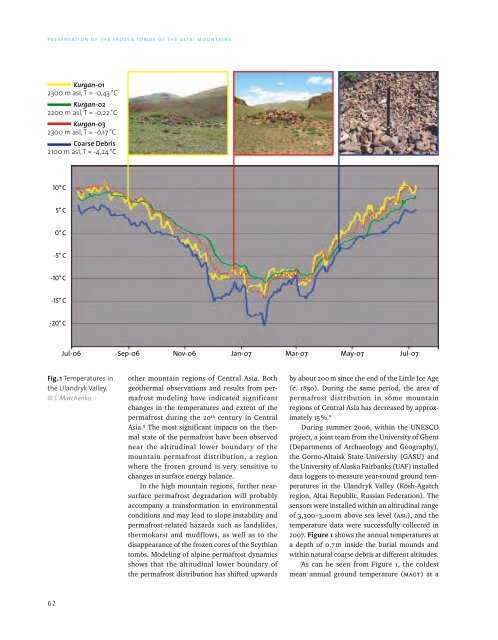Scythian Culture - Preservation of The Frozen Tombs of The Altai Mountains (UNESCO)
You also want an ePaper? Increase the reach of your titles
YUMPU automatically turns print PDFs into web optimized ePapers that Google loves.
PRESERVATION OF THE FROZEN TOMBS OF THE ALTAI MOUNTAINS<br />
Kurgan-01<br />
2300 m asl, T = -0,43 °C<br />
Kurgan-02<br />
2200 m asl, T = -0,22 °C<br />
Kurgan-03<br />
2300 m asl, T = -0,17 °C<br />
Coarse Debris<br />
2100 m asl, T = -4,24 °C<br />
10° C<br />
5° C<br />
0° C<br />
-5° C<br />
-10° C<br />
-15° C<br />
-20° C<br />
Jul-06<br />
Sep-06 Nov-06 Jan-07 Mar-07 May-07 Jul-07<br />
Fig. 1 Temperatures in<br />
the Ulandryk Valley.<br />
© S. Marchenko.<br />
other mountain regions <strong>of</strong> Central Asia. Both<br />
geothermal observations and results from permafrost<br />
modeling have indicated significant<br />
changes in the temperatures and extent <strong>of</strong> the<br />
permafrost during the 20 th century in Central<br />
Asia. 8 <strong>The</strong> most significant impacts on the thermal<br />
state <strong>of</strong> the permafrost have been observed<br />
near the altitudinal lower boundary <strong>of</strong> the<br />
mountain permafrost distribution, a region<br />
where the frozen ground is very sensitive to<br />
changes in surface energy balance.<br />
In the high mountain regions, further nearsurface<br />
permafrost degradation will probably<br />
accompany a transformation in environmental<br />
conditions and may lead to slope instability and<br />
permafrost-related hazards such as landslides,<br />
thermokarst and mudflows, as well as to the<br />
disappearance <strong>of</strong> the frozen cores <strong>of</strong> the <strong>Scythian</strong><br />
tombs. Modeling <strong>of</strong> alpine permafrost dynamics<br />
shows that the altitudinal lower boundary <strong>of</strong><br />
the permafrost distribution has shifted upwards<br />
by about 200 m since the end <strong>of</strong> the Little Ice Age<br />
(c. 1850). During the same period, the area <strong>of</strong><br />
permafrost distribution in some mountain<br />
regions <strong>of</strong> Central Asia has decreased by approximately<br />
15 %. 9<br />
During summer 2006, within the <strong>UNESCO</strong><br />
project, a joint team from the University <strong>of</strong> Ghent<br />
(Departments <strong>of</strong> Archaeology and Geography),<br />
the Gorno-<strong>Altai</strong>sk State University (GASU) and<br />
the University <strong>of</strong> Alaska Fairbanks (UAF) installed<br />
data loggers to measure year-round ground temperatures<br />
in the Ulandryk Valley (Kosh-Agatch<br />
region, <strong>Altai</strong> Republic, Russian Federation). <strong>The</strong><br />
sensors were installed within an altitudinal range<br />
<strong>of</strong> 3,300–3,100 m above sea level (asl), and the<br />
temperature data were successfully collected in<br />
2007. Figure 1 shows the annual temperatures at<br />
a depth <strong>of</strong> 0.7 m inside the burial mounds and<br />
within natural coarse debris at different altitudes.<br />
As can be seen from Figure 1, the coldest<br />
mean annual ground temperature (magt) at a<br />
62
















